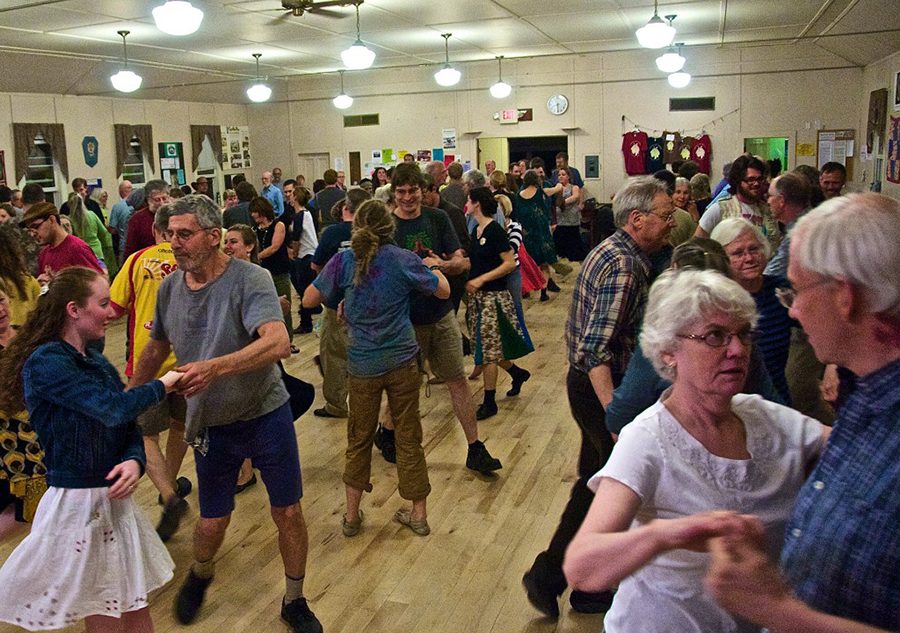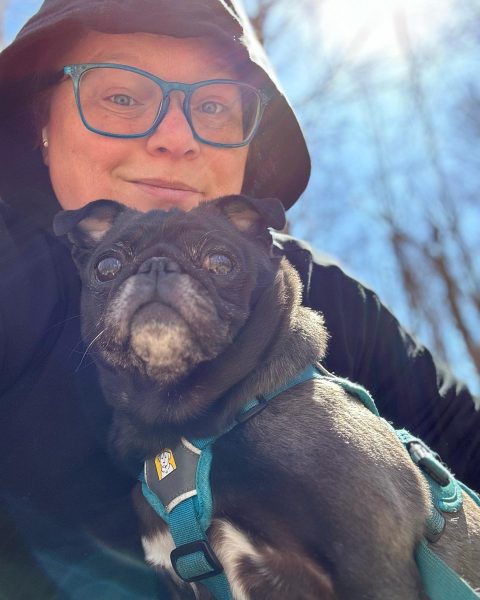Just dance!
Contra dancing in Montpelier
The sounds of fiddles and cellos being tuned and warmed up gently echo around the spacious ballroom, the hardwood floors glinting. Windows stretching from floor to ceiling line the walls of the room, and a modest chandelier casts a golden glow onto the bustling crowd below it. People of all ages mingle and chatter, the sounds of laughter and excited conversation ribboning throughout the air. Some wear flowing, vintage, floral patterned dresses. One person sports a kilt, knee-high socks, a crisp grey vest and a brown paperboy style hat. Others wear blue jeans and sneakers. Some are simply barefoot.
Suddenly, everyone is pairing up with a partner and joining in circles of four, holding their partner’s hand in one hand, their neighbor’s hand in the other, four lines comprised of about 20 individuals forming. Someone steps up on the small wooden stage overlooking the ballroom. The pianist on stage begins with a jaunty beat, the cello and fiddles join in, and on the fourth beat, everyone is off.
Skillfully choreographed mayhem ensues, with everyone twirling, spinning with their own and others’ partners and weaving in between other dancers in a dizzying display of deft footwork and graceful ease. This is not a cult ceremony. This is not a square dance party from the 80s. This is not a scene from a Jane Austen film. This is contra dancing.
Yuka Oiwa, a Vermont native, has been contra dancing off and on for the past six years, but recently got back into contra dancing scene in Vermont.
“If you had a freeze frame, people would be arranged like they would in those Jane Austen dances, in long lines facing partners,” said Owia. “Then the moment you unfreeze the scene, everyone would be having much more fun, swinging their partners and pounding their feet.”
Contra dancing is a folk dance style that has a long and rich cultural history with mixed origins from English, Scottish and French dances from the 17th century. Not to be mistaken for line dancing or country dancing, contra dancing is a unique community dance experience that some describe as being New England folk dance or Appalachian folk dance.
“It is a community dance. This means that the people in attendance represent all walks of life, traditions, beliefs, persuasions and ages,” said Daniel Wilkinson, a graduate of Johnson State College who has been an avid contra dancer throughout Vermont for the past seven years. “Succinctly, contra dancing is about community and creates connections where there were previously none. It helps to humanize your immediate surroundings.”
For some who are intimidated by dancing and have no prior experience with any form of it, contra dancing with complete strangers may seem intimidating. However, seasoned dancers and newcomers alike swear that contra dancing is something everyone can enjoy.
“It’s the perfect combination of community, live music and fun. You can join in with any level of dance experience and be able to enjoy yourself and meet new and interesting people along the way,” said Oiwa.
No partner is needed prior to attending a contra dance. In fact, one of the most enjoyable parts of a contra dance is inviting or being invited by a pleasant stranger to dance. This adds a charming, old-fashioned vibe to the event that often leads to interesting conversations and possible friendships with your new dance partner. One of the most surprising aspects of contra culture is the intimacy and openness you experience while dancing one-on-one with strangers.
Sean Adler, a junior at Johnson State College, has contra danced for the past three years in communities throughout Oregon and within the small town of Star Lake in the Adirondacks before arriving in Vermont. He has since found a place in the contra dance community in Montpelier, Vermont.
“I think my favorite thing is that I get to interact with a bunch of people I’ve never met while doing something that makes us happy,” said Adler.
Every first, third and fifth Saturdays, The Montpelier Contra Dance Umbrella hosts contra dances for the public to attend at the Capital City Grange in Montpelier, Vermont.
A beginner’s introduction dance starts at 7:30 p.m. to help accustom newcomers to dance floor etiquette, basic steps and maneuvers.
“Anyone can do it anytime, you don’t need to have ever done it before to join in,” said Adler. “It is so welcoming and low stress that I’m surprised more people don’t do it.”
Many of you may be wondering, “How on earth am I supposed to know exactly how to dance along with all of these complete strangers?” Fear not, for each step you need to take to properly dance along is announced out loud to the crowd by the person positioned at the microphone. This person is known as the caller and their job is to announce the layout of steps, called figures.
In a single dance, a caller may include anywhere from six to 12 figures, which are repeated as couples move up and down the lines of dancers, with each couple switching to new neighbors in each set. These 12 figures put into different arrangements are what each individual contra dance is comprised of.
“Once a person knows those base moves, they can then go on to dance any contra dance proficiently,” said Wilkinson. “This is where the special part comes in, people who view themselves as clumsy or ‘just don’t dance’ find that they can manage to feel confident and even graceful while contra dancing.”
Another opportunity to join in the dance is through the Mad Robin Callers Collective, a contra dance organization whose main focus is mentoring and helping experienced callers hone their skills as well as help cultivate new callers who will carry on the tradition. The Mad Robins Callers Collective hosts a contra dance on the fourth Saturday of every month at the First Congregational Church in Burlington, Vermont.
Starting out with slower and simpler dances and typically becoming more and more advanced as the night progresses, contra dance has something for everyone. These dances can vary from wildly dizzying with twirling and spinning maneuvers, to jaunty and simple figures, to calm, slow waltzes to help dancers wind down after the main dances conclude. Switching from neighbor to neighbor gives each dancer a chance to check out potential new partners for later.
“I found that contra dances are spaces rooted in a dancing tradition that teaches people, of every age, how to join in the steps and add their own flair to what’s being called,” said Oiwa.
During contra dances, which comprise newcomers and seasoned veterans alike, there are always going to be some mistakes and missteps being made. However, wrong turns, missed beats or one too many steps are all part of the contra adventure, with any mistakes being met with kind laughter and a guiding hand from a partner or neighbor to help get back on track. In contra, mistakes are part of the fun of learning and interacting with people from all skill levels.
“Contra dancing was one of the first places I felt comfortable dancing in public,” said Oiwa. “Especially after years of awkward middle school dances, trying to undulate to pop music while avoiding eye contact with anything but the floor.”
The three lines of dancers have flowingly migrated up and down the ballroom multiple times as the mix of cello, fiddle and piano music slowly comes to an end. Couples separate and chatter, the sounds of laughter and shortness of breath blending together. The air smells of sweat and an electric energy courses through the room. Another kind of dance ensues as people weave around and in between each other, finding new partners and new neighbors, and grabbing quick gulps of water as the band and the caller readies themselves. Soon they will all be off again.






